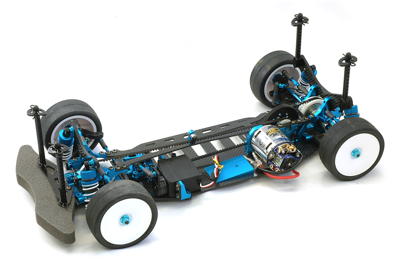
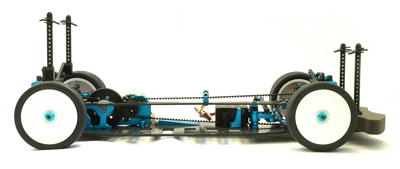
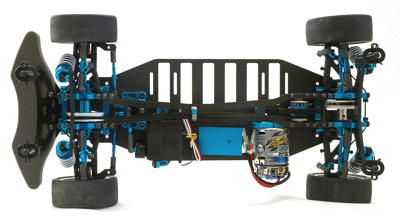 The third generation of the TRF touring car line began in December of 2007 with the 42106
TRF 416 chassis only 2 months after the last version of the
previous generation (TRF 415MSXX Marc Rheinard Edition). Unlike the
basic model TRF 415, this did not get a production 58xxx designation and
was therefore limited
edition like all future TRF releases. The photo on the cover of
the manual shows a 49386 10T Transpeed MS brushed motor installed. The first update came out the following December and was
designated the 42138 TRF 416 World Edition. This version was based on the changes driver Marc Rheinard made to win the IFMAR ISTC1
world championship earlier in 2008 and was the first to show a
brushless motor being used in the photograph on the cover of the
manual. Tamiya was not yet marketing their own brushless motors at
the time, but the IFMAR records indicate Marc used a sensored Speed
Passion motor. The following December (an interesting one year
cycle is developing here) Tamiya released the 42162
TRF 416X which incorporated most of the same changes as the World
Edition except for the fluorine bearings and "HL" coating on the shock
bodies, making it effectively a "lite" version of the World Edition
(although it actually sold for more). The manual photo reverted to
a brushed motor, this time a much lower cost 53696
23T Super Stock TZ. I present a detailed list
of the changes to
each generation of the model in the table below. The bullets shown
in italics represent the differences between the 416WE and 416X.
The third generation of the TRF touring car line began in December of 2007 with the 42106
TRF 416 chassis only 2 months after the last version of the
previous generation (TRF 415MSXX Marc Rheinard Edition). Unlike the
basic model TRF 415, this did not get a production 58xxx designation and
was therefore limited
edition like all future TRF releases. The photo on the cover of
the manual shows a 49386 10T Transpeed MS brushed motor installed. The first update came out the following December and was
designated the 42138 TRF 416 World Edition. This version was based on the changes driver Marc Rheinard made to win the IFMAR ISTC1
world championship earlier in 2008 and was the first to show a
brushless motor being used in the photograph on the cover of the
manual. Tamiya was not yet marketing their own brushless motors at
the time, but the IFMAR records indicate Marc used a sensored Speed
Passion motor. The following December (an interesting one year
cycle is developing here) Tamiya released the 42162
TRF 416X which incorporated most of the same changes as the World
Edition except for the fluorine bearings and "HL" coating on the shock
bodies, making it effectively a "lite" version of the World Edition
(although it actually sold for more). The manual photo reverted to
a brushed motor, this time a much lower cost 53696
23T Super Stock TZ. I present a detailed list
of the changes to
each generation of the model in the table below. The bullets shown
in italics represent the differences between the 416WE and 416X.1 International Federation of Model Automobile Racing, International Scale Touring Car class
There was also a modification available. All of the TRF 416 versions were configured for batteries using separate sub-C racing cells. If you wanted to use one of the then new lithium batteries instead, you could get the 42182 TRF 416X Upgrade Kit which changed the upper and lower chassis decks and battery supports.
| TRF 416 World Edition Changes |
TRF 416X Changes (compared to basic 416) |
|---|---|
|
|
At first glance the chassis is barely distinguishable from the TRF 415 MSXX. Like all the TRF touring car chassis, this a twin belt driven 4WD model with carbon fiber chassis plates, loads of machined aluminum parts, and generally the best parts Tamiya could come up with including hardware and axles. The general layout with the electronics on one side and the battery on the other is the same. The real changes are all in the details and are explained much further in my build journal below.
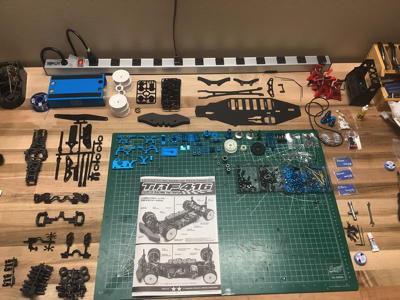 Page 1: Unboxing |
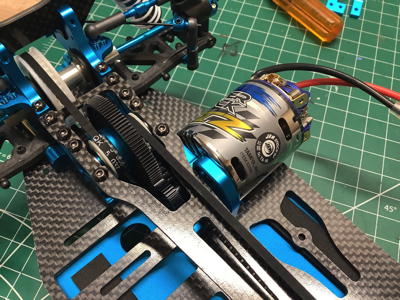 Page 2: Chassis Assembly |
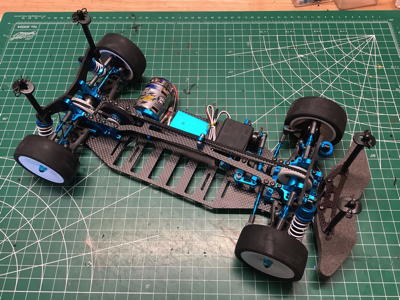 Page 3: Final Photos |